
Books by Hugh Brewster. Visit Hugh Brewster's website at www.hughbrewster.com and www.whitfieldeditions.com.
Hugh Brewster
Profile by Dave Jenkinson.
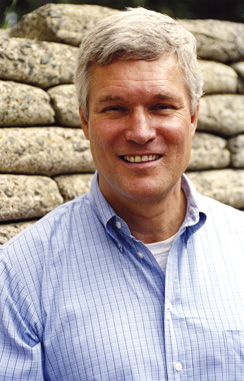 Born in Roumford, Essex, England, on May 26, 1950, Hugh has two older brothers and a younger sister. "We moved back to Scotland where my parents were from when I was two and then came to Canada when I was six. We all had strong Scottish accents when we arrived in Georgetown, ON, in 1956 but quickly lost them, just like the kilts that we shed after the first Sunday in church. Today, Georgetown has a wonderful children's bookstore, The Freckled Lion, and when I did a book signing there last year, a remarkable number of people came who remembered our family. One of the older ladies said, 'Oh, yes, we remember that first Sunday. You walked down the aisle in church, the three of you boys in your kilts.' At the time, we were mortified and couldn't get rid of the kilts quickly enough."
Born in Roumford, Essex, England, on May 26, 1950, Hugh has two older brothers and a younger sister. "We moved back to Scotland where my parents were from when I was two and then came to Canada when I was six. We all had strong Scottish accents when we arrived in Georgetown, ON, in 1956 but quickly lost them, just like the kilts that we shed after the first Sunday in church. Today, Georgetown has a wonderful children's bookstore, The Freckled Lion, and when I did a book signing there last year, a remarkable number of people came who remembered our family. One of the older ladies said, 'Oh, yes, we remember that first Sunday. You walked down the aisle in church, the three of you boys in your kilts.' At the time, we were mortified and couldn't get rid of the kilts quickly enough."
My parents were already in their forties when they emigrated with a family of four children. After the war, my father had gone back to medical school to get degrees in surgery, but in the UK he thought he would have to, as he said, 'wait in a dead man's shoes' to get a surgery post. Someone he had been to medical school with had come to Canada and suggested my father join him in Georgetown. After seven years there, we moved to Guelph, a bigger place with a bigger hospital."
Hugh's childhood career plans were initially somewhat unusual. "First of all, I wanted to be a missionary because our family was rather devout. I know this makes me sound like I'm out of another century, but the the 'lives of missionaries' books that I was given to read, about people like Mary Slessor and David Livingstone, made going to exotic places seem exciting."
"However, from a fairly early age, I did want to be a writer. We were denied TV, and the Georgetown Public Library was just over the fence. I could hop around to the old Congregational church that had been converted into a library and take out 'only four books at a time.' By the age of 10, I'd read the whole children's section and was allowed into the adult section. The Freckled Lion set up a reading recently at the Georgetown Library, and I took with me a copy of Ernest Thompson Seton's Two Little Savages, (no longer a politically correct title, I'm afraid,) that I had won there in a library contest in 1960. It was a contest featuring quotations from famous children's books, and I knew them all and won the Seton book which I've kept ever since. Libraries have been a huge part of my life."
"After high school, choosing what to study at university was easy because there were only a few things I was good at. I was hopeless at science and math while English and history were the only two things at which I actually shone. My BA from the University of Guelph is in English, and my minor was in theatre, an area in which I was always interested."
"After I completed university, there was naturally the question of 'What does one do with an English degree?' It was 1971, the long-haired times, and so I came to Toronto and wrote for various small, far-out magazines. Then I got a job reading manuscripts part-time which I parlayed into a full-time job in book publishing. The first real job I had was with Scholastic."
"And, to my surprise, I stayed. Back then, Scholastic was a small office attached to a warehouse in Richmond Hill. It seemed very far away from the more glamorous world of McClelland & Stewart and Macmillan in downtown Toronto, but I quickly realized that Scholastic had this extraordinary reach into schools and was a remarkable reading motivator for kids. Larry Muller, who was then the editorial director and my boss, was just full of energy and enthusiasm for starting new Canadian publishing programs and selling Canadian books through book clubs. Gordon Korman was one of the early superstars."
"I often tell the story that we used to joke that Larry never met a book he didn't like. No matter how bad some of these early manuscripts were, Larry always wanted to fix them and make them publishable. And he was right. We had to publish, and sometimes you have to publish authors even when they're not quite there yet. In Canada, back in the 70s, things were very much in a developing state, and so Larry simply began publishing children's books, and by their second, third or fourth book, the writers got better."
"Larry was remarkable and tireless. He'd go off to New York where the American book clubs were controlled by some rather steely women (whom we called the Iron Butterflies) who didn't think that what Larry was doing was 'good enough' for the American book programs. Larry persisted, and Scholastic is now a major force in Canadian publishing. It was fun to be at Scholastic when all that started. I also introduced a number of book clubs on my own, including a teachers' book club and a parents' book club. The teachers' book club still goes on and does very well."
"In 1981, I got the opportunity, which I took, to go to Scholastic New York, and I came back in 1984. Before I had left Toronto, a friend of mine, Al Cummings, had wanted to start a book packaging company, Madison Press Books, and so I helped out by performing editorial work. By 1984, the company was doing fairly well, and it looked like it could support another person so I came back from New York."
For those unfamiliar with the term "packager," Hugh explains: "The preferred term is 'independent book producer' because 'packager' confuses people – they think of boxes and styrofoam pellets. But a book packager is someone who develops an idea and concept for a book and delivers it to a publisher, either as a final disk and the publisher does the printing, or as a finished 'printed' book for which the publisher then does the distribution. Illustrated books have generally been the domain of packagers because they are quite labour intensive and because most publishers don't have the time and staff to work on them."
"There are other kinds of packagers as well. People I worked with at Scholastic went on to form a packaging company called Parachute Press, and they developed series like 'Goosebumps.' Dan Weiss, someone else I worked with at Scholastic, founded a company that today produces YA fiction series, including some very successful ones like 'Gossip Girls.' Many people don't realize that books like Sisterhood of the Traveling Pants are the product of packagers."
"So, while there are different kinds of packagers, basically a company like Madison comes up with the concept and then has to sell that idea to a publisher, generally with quite elaborate mockups, proposals and chapter outlines. The packager invests a lot of time and money with no guarantee that anyone will be interested."
"Madison had had a great success in 1981 with the first Robert Bateman book, The Art of Robert Bateman. In 1984, we did a second one, The World of Robert Bateman which was hugely successful, and after that followed Robert Ballard's The Discovery of the Titanic which has sold 1.5 million copies and been translated in over 14 countries. Having been at Scholastic, I naturally started the children's program at Madison. I stayed as editorial director with Madison for 20 years and was responsible for much of the creative side of the business. Many of the books were ideas of mine, but I really only started writing, or putting my name on the books almost out of necessity."
"After The Discovery of the Titanic, I thought, 'Well, what other stories have this kind of incredible appeal and enduring allure?' The bones of the Russian Imperial Family had just been discovered in a Siberian forest, and so we flew to Russia with a photographer and were among the first people to be allowed into a room in the State Archives where they had kept all the possessions of the Imperial Family after they were shot in 1918. I remember looking through the photo albums, the diaries and the little girls' school notebooks, things that were just so personal and heartbreaking, and thinking, 'There has to be a children's book in this.'" 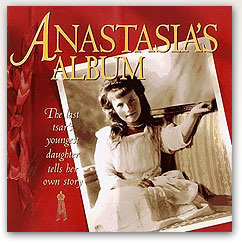
"I had intended for someone else to write the text to Anastasia's Album, but that person was over-scheduled, and when you're a packager, you can't postpone books you have to deliver. So I wrote the text and compiled the book, and it won the Red Cedar and the Silver Birch Awards. I found I rather enjoyed the attention, and I really liked going into schools. Having kids come up and say, 'I loved the book,' and telling them the story behind the book, as well as about things that weren't in the book, was just wonderful."
"Polar, the Titanic Bear was another success. It started as a manuscript that had been written by a Titanic survivor many years ago and put away in a family trunk. It needed a lot of rewriting and editing, but we polished it up into a book with lovely illustrations by Laurie McGaw that's really become kind of a classic."
Another children's book grew out of a successful Madison book for adults, Titanic: An Illustrated History. "Movie director James Cameron took this lavish book under his arm and went around to all of the Hollywood studios, saying, 'Look at this book. This is what I want to do with my film about the Titanic.' Ken Marschall, the amazing Titanic illustrator, and historian Don Lynch, who wrote the text for that book, were hired by Cameron as consultants for the making of the movie. They gave me blow-by- blow reports of the building of the Titanic sets at Rosarito Beach in Mexico. Because of Cameron's reputation as a very successful director, having done movies like The Terminator and Aliens, I thought this movie could be huge. Consequently, Madison published a lot of books to coincide with the movie. Of course, it was the most popular movie ever made up to that time, and I said to Ken, 'Your illustrations could become a wonderful cutaway of the Titanic so let's do a giant cutaway book with a foldout inside. Inside the Titanic: A Giant Cutaway Book has sold at least a couple of hundred thousand copies." 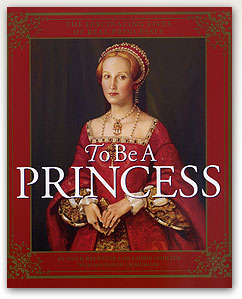
"Because Anastasia's Album had sold well, HarperCollins in the United States suggested, 'How about doing a book about other princesses?' The result was To Be A Princess which Scholastic published in Canada. To decide on which princesses to include, I started with a long chronological list and winnowed it down to10. Of course, the tragic princesses are the most appealing."
Laurie Coulter worked with Hugh on both To Be a Princess and 882 ½ Amazing Answers to Your Questions About the Titanic. "We were working together at Madison, and I soon realized with both projects that the research was just staggering. When you do something like To Be a Princess, you need to do as much research for each chapter as you would for a full book. I said to Laurie, 'Look, we're going to have to divide this up or else it just won't get done. The 882 ½ Amazing Answers...Titanic book appeared after the movie, but the publisher was afraid that the movie would quickly be passé, and so we had to do it a season ahead of when I intended. I remember that, even though I knew the story very well, Laurie and I hired a researcher and I took my fax machine to the cottage while I was on summer vacation. We continued to work back and forth on layouts to get that book done."
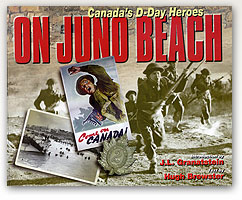
"Madison had done D-Day: The Greatest Invasion - A People's History, a big international coffee table book for the 60th anniversary of D-Day. While working on that book, I realized that the Canadian story was remarkable and that almost no Canadians knew about Juno Beach. I suggested that we do a children's book and approached Scholastic who said, 'OK, but we'd like it to be a kind of scrapbook approach.' I had already interviewed veterans for the adult book but then went out and did a lot more interviewing. On Juno Beach: Canada's D-Day Heroes was very successful and was nominated for the Silver Birch and the Red Cedar Awards and won the Information Book Award."
"This made me realize that there was a need for books not just about Canadian history, but about Canadian military history, in particular. It was an overlooked area because for years war was not thought to be a fit subject for children. That's all changed, and I think the Holocaust has had a lot to do with it as it has become part of school curricula. To understand the Holocaust, you have to understand the war. I was really struck, particularly during the Silver Birch Awards, with all the students, girls too, who wrote to me, saying, 'On Juno Beach is my favourite book.' I thought it would be a worthwhile book but didn't expect it to actually be a popular one."
"When the book was nominated for BC's Red Cedar Award, I went to give talks in schools. In the book, there's a very touching letter from an officer who had buried one of his men in an orchard, and he wrote to the parents: 'I buried your son in an orchard, and we made a cross for him.' A teacher came up to me with the actual letter. The buried soldier was her uncle. This made me realize how very close that war still is."
"My father and mother were a doctor and a nurse respectively in World War II. My mother didn't like to talk about the war in our home. I think that whole generation didn't talk about it very much, and that's part of the reason why war was not studied in schools for many years. But it was through those two world wars that Canada really emerged as a separate nation from Great Britain. After the Great War, the Statute of Westminster gave us control of our foreign policy, and after the Second War, Canadian citizenship was instituted. The wars contributed greatly to the Canada of today, and yet we so often overlook them."
"When I worked for Scholastic in New York, I would go to teachers' conferences where there was much talk about core curriculum and what every American child should know. With regard to US history, they would say, 'When leaving grade school, every American child should know about Washington at Valley Forge, should know about Gettysburg, should know about Pearl Harbor,' but in Canada, our equivalents are unknown. When the Dominion Institute did a national survey a few years ago, it was shocking how few Canadians had heard of Juno Beach. Even fewer had heard of Vimy Ridge."
With 2007 being the 90th anniversary of the Vimy battle, it made sense to do a book about it. As soon as Scholastic agreed to take it, I then had 'seller's remorse' because I thought, 'Wait a sec. World War I isn't part of the curriculum until grade 9 or grade 10 which is a little beyond my normal audience level. When I was in schools talking about On Juno Beach, I would say, 'My next book is going to about Vimy Ridge. Does anybody know what Vimy Ridge is?' No? 'Does anybody know about World War I?' No? I then thought, 'This could be tough.'" 
"But soon, almost every other adult I would meet would say things like, 'My uncle was at Vimy Ridge. I've got a collection of his stuff in the basement. Come and see it,' or 'Do you know so and so? Her dad was at Vimy, and she's got his helmet and his medals.' All across this country, there are virtual museum in attics and in drawers of Vimy artifacts. Fortunately, the Vimy anniversary and rededication of the monument was a very big celebration, and so Canada's role in. World War I was rediscovered. At Vimy Ridge was well received and was selected as the Honour Book for the Information Book Award."
"I've always been fascinated by the First World War. It was sheer madness and an appalling waste of human life, but its impact on this country was huge. In World War I, Canada was a country of seven and a half million people, and 625,000 young men served in that war. Every little town I visit for school readings, I first go to the town's cenotaph or war memorial and count the names. Then I ask the students, 'How many of you have been to the cenotaph?' Even when the memorial is right across from the school and the kids have played in the park, they have no clue what it is. I'll say, 'I was just there, and this town was probably a thousand people in 1914-1918, and there are 35 names on that monument. Think about that. Thirty-five men from a town of that size.'"
Book ideas can seemingly come at any time and place. "On Juno Beach" was nominated for BC's Red Cedar Award, and the awards ceremony was held in Comox. I was presenting to students, and a parent had invited a Dieppe vet, a flier, to come to my presentation. Knowing this, I shortened my talk about Juno and said, 'Before Juno, there was Dieppe, and we have somebody here who was actually at Dieppe.' His name was Duke Warren, and I've put his story in my latest book for Scholastic, entitled Dieppe: Canada's Darkest Day of World War II, which will be published in Spring 2009.."
"Meeting Duke made me think, 'I'd better get these stories while these veterans are still with us because several hundred are dying every few months. A defeat like Dieppe is harder to write about than victory, and this was the hardest book of the three 'war' books to write even though the raid, itself, all took place in one day, one morning. Making the story accessible to kids in just 48 pages was challenging."
"Most people don't know that, after Dieppe, the Canadians were chained up in prison camps because the Germans had found the plans for the raid. In them were orders to tie the hands of any German soldiers taken prisoner so they wouldn't destroy documents or other information. They were to be taken back to England where they would then be 'unhandcuffed.' When Hitler learned of this order, he said that, until Churchill apologized, the 1,500 Canadians captured at Dieppe would have their hands tied in prison camps."
"For two weeks, their hands were tied in front of them,and then for two weeks they were tied behind them. Their wrists soon became infected, and so their German captors shackled them. In the Red Cross boxes that the Canadian POWs received, there were corned beef tins with keys for opening the cans, and they managed to fashion these into keys that would unlock the shackles. If the POWs took them off, they were punished, but, during the day when the guards weren't looking, they would take the shackles off and dig tunnels and hatch fantastic escape schemes. Stalag VIII-B, which is where the Dieppe prisoners were sent at least for the first year or so, was one of the most successful camps in getting prisoners back to England. In 1944, as the Russians were advancing, the Germans rounded the prisoners up marched them west in what became known as the Great Death March. They were an emaciated group at the end of the march."
"When these events happened,.the veterans were teenagers, mainly. I just loved talking to these men because that profound experience at a very young age has shaped them for the rest of their lives. They still use expressions right out of the '40's like, 'We were browned off.' They have incredible stories of the kind that our generation has never experienced. I found it very affecting to attend the 65th anniversary of the Dieppe Raid last summer with my nephew who takes the photographs for the books. When we stood on Blue Beach and the veterans saluted their dead comrades while O Canada was played -- you can imagine how moving that was."
"I still 'package' or produce the books I write. With a designer, I lay it all out. My nephew and I have now got into the habit of going to the locales, getting the feel of the place, taking photographs that are then used in the book, with lots of the photos being 'then and now' combinations." 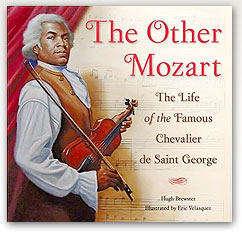
In addition to his "war" books, Hugh has also done a couple of books with an arts connection. The Other Mozart had its beginnings as Hugh was listening to CBC Radio 2 one day. "A classical music buff, I can recognize most composers, with Baroque and Classical composers being a little tougher because a lot of them sound the same, but here was a particularly lilting piece of music on the CBC. I thought, 'Not Mozart. Maybe it's Telemann, Vivaldi, Haydn?' Then the announcer came on and said, 'That was the Chevalier de St. Georges who was known as 'le Mozart Noir', the Black Mozart, and he lived an incredible life. He was a fencer, a musician and a composer and Rhombus Media is working on a film which will be out shortly.'"
"And I thought, 'Well, that sounds interesting.' I knew that there was a dearth of good African American heroes to write about. Martin Luther King, Jr. and Harriet Tubman can only be done so many times. I researched Joseph Boulogne, aka le Mozart Noir, and thought, 'There's a great story here,' and so I did it and sold it to Abrams."
"Even now, there are things about his life that aren't known. He was very, very famous when he lived, but, after he died, there were a number of accounts that were written that were rather fantastic, and so separating fact from fiction was a challenge. After his death, his music was 'lost,' but now more and more of it is being rediscovered. Some of the operas he wrote are being performed. There has actually been an opera written about his life, and there is a street named after him in Paris"
"He lived an extraordinary life. A champion fencer and a courtier, he had his own orchestra and was a conductor. He conducted the first performances of Haydn's Paris Symphonies. He was the first black officer in the French army during the French Revolution. He was one of these people who did so much that, if he had had more time to write music, he would have written even more. Tall and extremely handsome, he had a good romantic life, too, but that aspect of his life was just discreetly hinted at in the book. Something that's not in the book is that he reportedly had a pillow that was stuffed with locks of hair from each of his 'conquests.' As an aristocrat, there were no women of colour of his class, and so he could never marry. Nobody from aristocratic circles wanted their daughter to marry a 'mulatto.'"
"John Singer Sargent had always been one of my favourite painters, and his era, dubbed, the 'Gilded Age,' has always interested me. On seeing 'Carnation, Lily Lily Rose', one of Sargent's best-known paintings, questions like 'Who were those girls, and where was it painted?' arose. Al Cummings, my partner at Madison, had been at the Tate Gallery and had brought back a little booklet that the Tate had done about the story behind the painting. It was very academic, but from it I gleaned enough information to know that they were real girls and that there might be a story there. The subject matter wasn't commercial enough to ever be a Madison book, but I thought, 'You know, when I have the time, that'll be an idea I'd like to pursue.' While I was in Washington, I learned that the picture was painted in the garden of a house belonging to Frank Millet, an American expatriate painter living in England. I already 'knew' all about Frank Millet because he died on the Titanic." 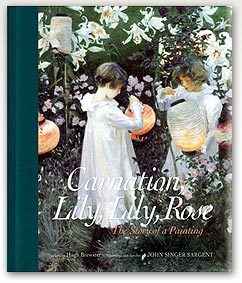
"I thought, 'There's no escaping the Titanic -- six degrees of separation and all that.' I must do this book. Consequently, after my tour around Vimy with my nephew, we came back to England and went to Broadway, a beautiful little town in the Cotswolds, where there had been an artists colony in 1885-1886 centred around the home of Frank Millet. It was all still there just as it was. I did more research and got the feel of the place. I then went to Washington and found the Millet family papers. To my delight, Frank Millet's sister, Lucia Millet, had come over from Massachusetts to be a kind of governess to Kate, the oldest daughter. Lucia wrote a letter every other day, saying things like, 'Everybody in London wanted to see Oscar Wilde, but I didn't' and 'We went to see The Mikado, the hit new show, and now I'm in Broadway staying with the Millets. There's a man named John Sargent, and he's painting Kate in the garden.' Other famous people, like Edmund Gosse and Henry James, wrote about the Broadway artists' colony as well, so it was quite well-documented."
"Then I went out and looked at all the books about fine art for kids and thought, 'Well, they're mostly highly fictionalized,' not that there's anything wrong with that, but I realized, 'Here's a chance to tell a real story.' I wanted to make the book very thinly fictionalized and as true as possible so that everything in the book really happened or could have happened. It would be a real story about a real child's encounter with a painting and how art is 'hard' sometimes."
"Given that Sargent is a well-known American painter, I thought New York would be the place to sell the book. I went and saw all my publishing pals from my Madison days, and while they were all pleasant, nobody bought the book. I then asked an editor friend I had worked with at Madison to read the manuscript, saying, 'I've been an editor for 35 years, but I know that this isn't maybe quite there because people are turning it down.' She read it and said, 'Kate (my narrator) gets lost. You start out with Kate, and then you talk about the painting. So, is Kate the focus, or is the painting the focus?' I thought, "Hmm…that's a good point' So, even after all my years as an editor, I realized you still need an editor no matter who you are."
After Hugh's direct- sell foray in New York, the sale of Carnation, Lily Lily Rose came about through happenstance. "Valerie Hussey, then the president of Kids Can Press, is an old friend, and while we were having lunch one day, she asked, 'What are you working on?" I showed her 'Carnation, Lily,' saying, 'Oh, this wouldn't be for you' kind of thing. The unintended reverse psychology worked. Kids Can liked it and bought it.""
"I know from my publishing experience how hard it is to sell books. You have to get out there. I spent all of last fall promoting books, giving talks and touring, working my heart out to make Carnation, Lily Lily Rose and other books succeed . I hosted a wonderful charitable garden party and put on a play version of Carnation, Lily Lily Rose which was all very successful. Now I'm writing a real play which will be the school play for Branksome Hall, an independent girls school in Toronto."
"Broadway, the setting for the book, is a tourist town, and so when I went back to Broadway with copies of the book for people that I met there, I suggested, 'Why don't you do an arts festival, and we could do the play right here where it all took place? It would draw tourists and wouldn't that be great?' I thought that would be the end of it, but it looks like they're going to do something, and they do want to put on a play. As a result, I'm expanding on the play and making it a musical."
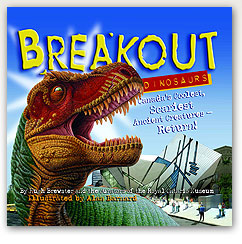
Hugh turned to one of kids' favourite topics with Breakout Dinosaurs. "I knew people at the Royal Ontario Museum, aka the ROM and suggested that the ROM should have a children's book program. The ROM is well-known for its dinosaur collection and suggested that we start with dinosaurs. Since the ROM was going to be reopening its dinosaur wing, I thought it would be cool to make it about Canadian dinosaurs and show what Canada was like 65 million years ago. 'Why are the Prairies flat?' Because they were under water. And sea monsters once swam in those waters over Winnipeg. I had done two dinosaur books with Allan Barnard, the illustrator, when I was at Madison. He's got a huge knowledge of dinosaurs. I published Breakout Dinosaurs myself through my company, Whitfield Editions, in conjunction with the ROM who agreed to buy some books for their store."
"I established Whitfield Editions in 2005, and, in addition to Breakout Dinosaurs, I've done a number of other books, including a big, beautiful book for adults about two pioneering writers, Susanna Moodie and Catherine Parr Traill entitlled Sisters in Two Worlds.
As to what's next, Hugh says, "I'm going back to Russia with my nephew. I'm thinking of writing a YA novel about that pre-revolutionary period in Russia. And I'm in discussions with Scholastic about doing a novel for them. So fiction seems to be in my future. I have an idea for an adult nonfiction book that would be a very big and rather daunting project. I imagine I'll keep on doing things as I always have. One project seems to inevitably lead to another, and another deadline is always just around the corner."
This article is based on an interview conducted in Toronto, June 3, 2008, and revised September, 2008. 